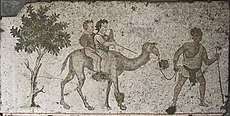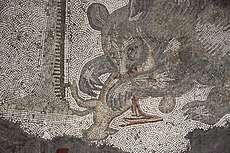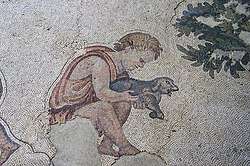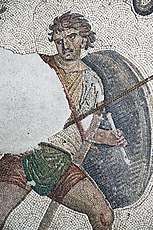Great Palace Mosaic Museum
The Great Palace Mosaic Museum (Turkish: Büyük Saray Mozaikleri Müzesi), is located close to Sultanahmet Square in Istanbul, Turkey, at Arasta Bazaar. The museum houses mosaics from the Byzantine period, unearthed at the site of the Great Palace of Constantinople.

History
The museum hosts the mosaics used to decorate the pavement of a peristyle court, dating possibly to the reign of Byzantine emperor Justinian I (r. 527–565), although more recent analysis hints at a later date, possibly even the reign of Heraclius.[1] It was uncovered by British archaeologists from the University of St Andrews in Scotland during extensive excavations at the Arasta Bazaar in Sultan Ahmet Square in 1935–1938 and 1951–1954. The area formed part of the south-western Great Palace, and the excavations discovered a large peristyle courtyard, with a surface of 1872 m², entirely decorated with mosaics. It was at this point that the Austrian Academy of Sciences, supervised by Prof. Dr. Werner Jobst, undertook to study and preserve the famous palace mosaic and to carry out additional archeological examinations (1983–1997) within the scope of a cooperative project with the Directorate General of Monuments and Museums in Turkey.
Gallery
 Floor mosaic of a woman carrying a pot (c. 5th century)
Floor mosaic of a woman carrying a pot (c. 5th century) Floor mosaic of a child and a donkey (c. 5th century)
Floor mosaic of a child and a donkey (c. 5th century) Shepherds with animals
Shepherds with animals Elephant
Elephant Dromedary ride
Dromedary ride Bear with prey
Bear with prey Boy and dog
Boy and dog Hunt scene
Hunt scene Decoration
Decoration Griffon attack
Griffon attack Arena play
Arena play
References
- Bardill, Jonathan (2004). Brickstamps of Constantinople. Oxford University Press. ISBN 9780199255245.
External links
| Wikimedia Commons has media related to Great Palace Mosaic Museum. |